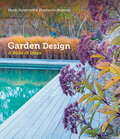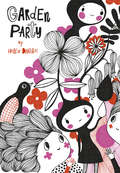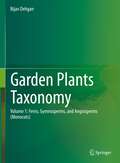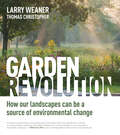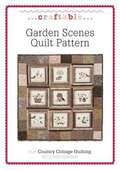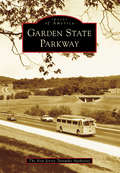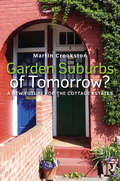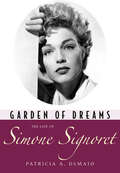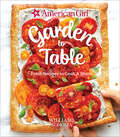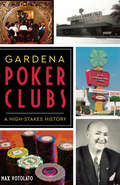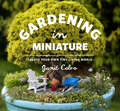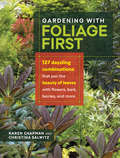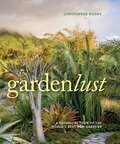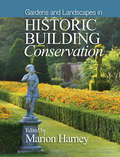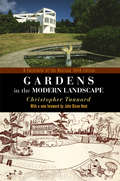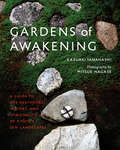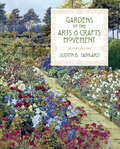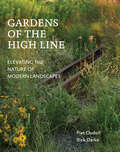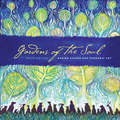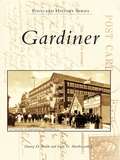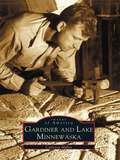- Table View
- List View
Garden Design: A Book of Ideas
by Marianne Majerus Heidi HowcroftWinner of the Garden Media Guild Book Photographer of the Year 2015'This book will inspire readers to envision what is possible even in the smallest, most improbable spaces'.Publishers Weekly'Just looking at Marianne's stunning photographs made me want to go outside and start re-thinking my plot....I defy any reader not to find a style they can feel comfortable with in this book, there are plenty of ideas which can be adopted, even for the most difficult location'.Reckless GardenerThere is no one way to design a garden. The variations and breadth of possibilities are astonishing but it is the choices of the individual that make the world of gardens so exciting. Creating a garden is part common sense and part instinct but we all need inspiration to help us realize the garden we want. Garden Design: A Book of Ideas is the must-have visual reference for garden owners, architects and designers. With over 600 images by award-winning photographer Marianne Majerus and incisive advice from garden designer and best-selling writer Heidi Howcroft, this book takes the reader from getting the concept right to choosing the perfect finishing touches for your outdoor space. The gardens featured are large and small, urban and rural in a wide range of styles from contemporary to classical to naturalistic. Every aspect of designing a garden is explored, from assessing your plot and soil to choosing a style as your inspiration, selecting the right components (be they hard landscaping, boundaries or plants) and tackling more challenging spaces.
Garden Party: (nature Themed Whimsical Book For Girls And Women, Beautiful Illustration And Quote Book)
by Helen DardikGarden Party is a collection of charming sketches and quotes from artist Helen Dardik.Dardik's pen-and-ink drawings are replicated from her sketchbooks and interspersed with quotes from classic novels such as Alice in Wonderland and The Secret Garden. Dardik's illustrations of girl-fairies, flora, and fauna create a magical, dreamy world. Many of her characters are hybrid girl/plant creatures whose friends include a menagerie of cats, dogs, and other critters.• Her illustrations are predominantly black-and-white, with a limited palette of accent colors.• Aesthetic feels equal parts vintage Scandinavian modern folk art and Japanese Kawaii culture,• Girl-powered and nature themed This is a charming, girl-centric book that is perfect for all occasions, whether it's a graduation or Mother's Day or simply for yourself. The book's design is also a delight—it looks and feels like an actual sketchbook.• A perfect book for teens, young adult women, and moms• Dardik's unique illustration style is at once elegant and whimsical.• Great for those who loved In the Garden of My Dreams: The Art of Nathalie Lété by Nathalie Lété. and How to Be a Wildflower by Katie Daisy
Garden Plants Taxonomy: Volume 1: Ferns, Gymnosperms, and Angiosperms (Monocots)
by Bijan DehganHorticulture has remained far behind in understanding of botanical principles. Recent phylogenetic (DNA-based) reorganization of higher plants has revolutionized taxonomic treatments of all biological entities, even when morphology does not completely agree with their organization. This book is an example of applying principals of botanical phylogenetic taxonomy to assemble genera, species, and cultivars of 200 vascular plant families of ferns, gymnosperms, and angiosperms that are cultivated for enhancement of human living space; homes, gardens, and parks. The emphases are on cultivated species but examples of some plants are often shown in the wild and in landscapes. In providing descriptions, it is assumed that students and other interested individuals have no background in general botany (plant characteristics), or nomenclature. Fundamental features of all plant groups discussed are fully illustrated by original watercolor drawings or photographs. Discussion of the families is grounded on recent botanical phylogenetic treatments, which is based on common ancestry (monophyly). Of course, phylogenetic taxonomy is not a new concept, and was originally based on morphological characteristics; it is the DNA-based phylogeny that has revolutionized modern biological classifications. In practical terms, this book represents the horticultural treatment that corresponds to phylogenetic-based botanical taxonomy, to which is added cultigens and cultivated genera and species. Hence, the harmony between horticultural and botanical taxonomy. This book covers phylogenetic-based taxonomy of Ferns, Gymnosperms, and Angiosperms (Monocots). A companion volume covers Angiosperms (Eudicots).
Garden Revolution: How Our Landscapes Can Be a Source of Environmental Change
by Thomas Christopher Larry WeanerAHS Book Award winner This lushly-photographed reference is an important moment in horticulture that will be embraced by anyone looking for a better, smarter way to garden. Larry Weaner is an icon in the world of ecological landscape design, and now his revolutionary approach is available to all gardeners. Garden Revolution shows how an ecological approach to planting can lead to beautiful gardens that buck much of conventional gardening’s counter-productive, time-consuming practices. Instead of picking the wrong plant and then constantly tilling, weeding, irrigating, and fertilizing, Weaner advocates for choosing plants that are adapted to the soil and climate of a specific site and letting them naturally evolve over time. Allowing the plants to find their own niches, to spread their seed around until they find the microclimate and spot that suits them best, creates a landscape that is vibrant, dynamic, and gorgeous year after year.
Garden State Parkway (Images of America)
by The New Jersey Turnpike AuthorityThe Garden State Parkway has transformed the lives of New Jersey residents since opening in 1954. Spanning 173 miles from Cape May to the New York State line, it has fostered tourism to the Jersey Shore and given commuters an easier way to get to work. Gov. Alfred E. Driscoll had envisioned the impact a new highway could have on the state, and a large team of planners, engineers, and contractors made it happen. In 1952, the legislature created the New Jersey Highway Authority to ensure the funding and completion of the $330-million parkway and to self-sufficiently operate the roadway through toll revenue. Garden State Parkway shows how this iconic roadway gained its place in history and continues to combine safe transportation in a parklike setting with the scenic beauty of New Jersey.
Garden Suburbs of Tomorrow?: A New Future for the Cottage Estates (Planning, History and Environment Series)
by Martin CrookstonNamed one of the Top 10 books about council housing - the Guardian online Faced with acute housing shortages, the idea of new garden cities and suburbs is on the UK planning agenda once again, but what of the garden suburbs that already exist? Over the first six decades of the twentieth century, councils across Britain created a new and optimistic form of housing – the cottage estates of ‘corporation suburbia’. By the early 1960s these estates provided homes with gardens for some 3 million mainly working-class households. It was a mammoth achievement. But, because of what then happened to council housing over the later years of the century, this is not very often appreciated. In Garden Suburbs of Tomorrow, Martin Crookston suggests that making the most of the assets which this housing offers is a positive story – it can be positive for housing policy; for councils and their ‘place-making’ endeavours; and for the residents of the estates. This is especially important when all housing market and development options are so constrained, and likely to remain so for the next decade or more. Following an examination of what the estates of ‘corporation suburbia’ are and what they are like, there follow chapters on specific examples from different parts of the country, on how they are affected by the workings of the housing market, and then – not unconnectedly – on how attitudes to this socially-built stock have evolved. Then the final chapters try to draw out the potentials, and to suggest what future we might look for in corporation suburbia in the twenty-first century.
Garden and Landscape Practices in Pre-colonial India: Histories from the Deccan (Visual and Media Histories)
by Daud Ali; Emma J. FlattThis book presents a set of new and innovative essays on landscape and garden culture in precolonial India, with a special focus on the Deccan. Most research to date has concentrated on the comparatively well preserved gardens and built landscapes of the celebrated Mughal empire, giving the impression that they have been lacking in other times and regions. Not only does this volume provide a corrective to such assumptions, it also moves away from traditional art-historical approaches by posing new questions and exploring hitherto neglected source materials. The contributors understand gardens in two related ways: first as real or imagined spaces and manipulated landscapes that are often invested with pronounced semiotic density; and second as congeries of institutions and practices with far-reaching social ramifications for the constitution of elite societies. The essays here present a multi-disciplinary approach to the study of garden culture in precolonial India, and together suggest several new and exciting directions of enquiry for those working in the Deccan, Mughal India, and beyond.
Garden of Dreams: The Life of Simone Signoret (Hollywood Legends Series)
by Patricia A. DemaioThe incomparable Simone Signoret (1921-1985), one of the grand actresses of the twentieth century and one of France's most notable stars, considered herself the “oldest discovery” in Hollywood. After years of block-listing during the McCarthy era, she was thirty-eight years old when she entered Hollywood through the back door in the 1959 British blockbuster Room at the Top. Her portrayal of the endearing Alice Aisgill earned her the Academy Award in 1960, the first French actor to win a coveted Oscar. Though a latecomer to Hollywood, Signoret was already an international star who had survived the Nazi occupation of Paris, emerging in 1945 as a beautiful, promising actress capable of communicating more emotion through body language than dialogue alone could achieve. She gained a reputation as the thinking man's sex symbol and in several films portrayed prostitutes with subtlety and depth. She was fiercely protective of her privacy. But after winning the Oscar, she was dragged through the gutter when her second husband, Yves Montand, had a widely publicized affair with Marilyn Monroe. Many attributed her rapid aging and alcoholism to this betrayal. She endured this perception in silence, all the while demonstrating a remarkable capacity to reinvent herself as a bestselling author, respected social activist, and revered actress who remained in the cinema, her “garden of dreams,” for over four decades. Patricia A. DeMaio combines Signoret's courageous story with Montand's biography to reveal new information and insight into Signoret's humanitarian efforts and the vibrant film career that sustained her.
Garden to Table: Fresh Recipes to Cook & Share (American Girl)
by American GirlMore than fifty recipes for kid-friendly dishes that highlight seasonal ingredients to inspire young chefs to learn about eating—and cooking—nourishing food. Garden to Table features more than fifty sweet and savory recipes that transform fresh produce into delicious dishes—like whipped-cream cake with layers of berries; mini peach and cherry pies; pink-frosted strawberry cupcakes; sweet potato skins topped with melted cheese; tempura fried string beans with yummy dipping sauce. In addition to essential cooking tips and kitchen safety knowhow, discover fun skills like using a vegetable peeler to “shave” veggies and tips for creating an indoor kitchen herb garden. Whether you want to make the perfect after-school snack for yourself, a decadent dessert for a party with friends, or dinner for your family, this beautifully photographed collection of recipes will inspire you to cook your way through the seasons—and through each chapter, from the veggie garden and berry patch to the fruit orchard and citrus grove. With this garden-to-table adventure, become a pro at transforming beautiful fresh fruits and veggies into super-delicious baked treats and meals.
Gardena Poker Clubs: A High-stakes History
by Max VotolatoEven in the midst of the Great Depression, gamblers flocked to Gardena. Colorful individuals like Ernie Primm fought for the legalization of commercial draw poker and established six iconic card clubs that thrived for generations. Russ Miller worked his way from Edgemont Club bouncer to owner of the Normandie Club. A criminal group called the Ver-Crans Corporation controlled the Horseshoe Club before being run out of town, selling its interest to Bow Herbert. Rival factions in the city waged war in the courts and the street over the coveted seventh card club license. And Larry Flynt bid his way to owning the Eldorado Club, which he rebuilt as the Hustler Casino. Author Max Votolato reveals the high-stakes stories behind Gardena’s famous poker rooms.
Gardening in Miniature: Create Your Own Tiny Living World
by Janit CalvoGet ready to journey into the huge world of growing small!The next garden trend combines the joy of gardening with the magic of miniatures. Gardening in Miniature is a complete guide to creating lush, living, small-scale gardens. It has everything you need to pick up this new hobby, including scaled down garden designs, techniques for creating tiny hardscapes, miniature garden care and maintenance, tips on choosing containers, how to buy the right plants, and where to find life-like accessories. Inspiring step-by-step projects feature basic skills that can be recreated in any number of designs, like a tiny patio, a trellis, a pond, and a secret garden.Whether you want to build a miniature empire in your garden bed or design a private garden with a pebble patio for an indoor centerpiece, Gardening in Miniature is the primer for creating your own tiny, living world.
Gardening with Foliage First: 127 Dazzling Combinations that Pair the Beauty of Leaves with Flowers, Bark, Berries, and More
by Karen Chapman Christina SalwitzCreate a foliage-driven garden that dazzles! Although seductive, flowers, by their fleeting nature, are a fickle base to provide long-lasting gardens with year-round interest. Tackle this problem with the advice in Gardening with Foliage First. Learn how to first build a framework of foliage and then layer in flowers and other artistic elements as the finishing touches. This simple, recipe-style approach to garden design features 127 combinations for both sunny and shady gardens that work for a variety of climates and garden challenges.
Gardenlust: A Botanical Tour of the World's Best New Gardens
by Christopher Woods“A beautiful tour through some of the loveliest gardens in the world!” —Peter H. Raven, President Emeritus at Missouri Botanical Garden A steep hillside oasis in Singapore, a garden distinguished by shape and light in Marrakech, a haunting tree museum in Switzerland—these are just a few of the extraordinary outdoor havens visited in Gardenlust. In this sumptuous global tour of modern gardens, intrepid plant expert Christopher Woods spotlights 50 modern gardens that push boundaries and define natural beauty in significant ways. Featuring both private and public gardens, this journey makes its way from the Americas and Europe to Australia and New Zealand, with stops in Asia, Africa, and the Arabian Peninsula. Along the way, you'll learn about the people, plants, and stories that make these iconic gardens so lust-worthy. As inspiring as it is insightful, Gardenlust will delight your passion for garden inspiration—and the many places it grows.
Gardens and Landscapes in Historic Building Conservation (Historic Building Conservation)
by Marion HarneyThis comprehensive guide on historic garden and landscape conservation will help landscape professionals familiarise themselves with what the conservation of historic gardens, garden structures and designed landscapes encompasses. The aim of the series is to introduce each aspect of conservation and to provide concise, basic and up-to-date knowledge within five volumes, sufficient for the professional to appreciate the subject better and to know where to seek further help. Gardens & Landscapes in Historic Building Conservation is an essential guide for everyone with an interest in the conservation of historic gardens and designed landscapes worldwide. The latest assessment of the origins, scope and impact of gardens and designed landscapes is vital reading. Covering history and theory, survey and assessment, conservation and management and the legislative framework the book considers all aspects of garden and landscape conservation and related issues. It explores the challenge of conserving these important sites and surviving physical remains and a conservation movement which must understand, protect and interpret those remains. This book demonstrates how the discipline of the history and conservation of gardens and landscapes has matured in recent decades, recognising the increased participation of professional contract and curatorial managers in the management of these sites and in conserving and interpreting landscapes. Drawing on a wide range of sources, combining academic and professional perspectives, the book provides information and advice relevant to all involved in trying to preserve one of England’s greatest cultural contributions and legacy for future generations to enjoy. With chapters by all the leading players in the field and illustrated by copious examples this gives essential guidance to the management and conservation of historic gardens and designed landscapes.
Gardens in the Modern Landscape: A Facsimile of the Revised 1948 Edition (Penn Studies in Landscape Architecture)
by Christopher TunnardBetween 1937 and 1938, garden designer Christopher Tunnard published a series of articles in the British Architectural Review that rejected the prevailing English landscape style. Inspired by the principles of Modernist art and Japanese aesthetics, Tunnard called for a "new technique" in garden design that emphasized an integration of form and purpose. "The functional garden avoids the extremes both of the sentimental expressionism of the wild garden and the intellectual classicism of the 'formal' garden," he wrote; "it embodies rather a spirit of rationalism and through an aesthetic and practical ordering of its units provides a friendly and hospitable milieu for rest and recreation."Tunnard's magazine pieces were republished in book form as Gardens in the Modern Landscape in 1938, and a revised second edition was issued a decade later. Taken together, these articles constituted a manifesto for the modern garden, its influence evident in the work of such figures as Lawrence Halprin, Philip Johnson, and Edward Larrabee Barnes.Long out of print, the book is here reissued in a facsimile of the 1948 edition, accompanied by a contextualizing foreword by John Dixon Hunt. Gardens in the Modern Landscape heralded a sea change in the evolution of twentieth-century design, and it also anticipated questions of urban sprawl, historic preservation, and the dynamic between the natural and built environments. Available once more to students, practitioners, and connoisseurs, it stands as a historical document and an invitation to continued innovative thought about landscape architecture.
Gardens of Awakening: A Guide to the Aesthetics, History, and Spirituality of Kyoto's Zen Landscapes
by Kazuaki TanahashiRenowned artist Kaz Tanahashi reveals the deep, inner spiritual connections that Zen gardens can foster, with over 75 stunning full-color photos of the masterpiece gardens of Kyōto, Japan.Imagine yourself in Kyōto, Japan, gazing at an ancient temple garden. How would you contextualize what you are seeing? What is the history of this centuries-old contemplative art form of Zen gardening? What are its symbols and concepts?Richly illustrated with full-color photographs, Gardens of Awakening guides you through a series of Zen temple gardens, most of which were created from the fourteenth through seventeenth centuries. Some are teeming with plants and flowing water, while others have only rocks and sand. All share in the Zen aesthetics of awakening.Through essays and commentary on Mitsue Nagase&’s striking photographs, beloved Zen artist and translator Kazuaki Tanahashi presents the gardens in terms of seven qualities that arise from Zen practice: direct, ordinary, vigorous, gleaming, pivotal, nondual, and inexhaustible. Relating these qualities to the development of Zen culture and its influence on Japanese art, Gardens of Awakening invites you deep into the heart of Zen.
Gardens of Renaissance Europe and the Islamic Empires: Encounters and Confluences
by Mohammad GharipourThe cross-cultural exchange of ideas that flourished in the Mediterranean during the sixteenth and seventeenth centuries profoundly affected European and Islamic society. Gardens of Renaissance Europe and the Islamic Empires considers the role and place of gardens and landscapes in the broader context of the information sharing that took place among Europeans and Islamic empires in Turkey, Persia, and India.In illustrating commonalities in the design, development, and people’s perceptions of gardens and nature in both regions, this volume substantiates important parallels in the revolutionary advancements in landscape architecture that took place during the era. The contributors explain how the exchange of gardeners as well as horticultural and irrigation techniques influenced design traditions in the two cultures; examine concurrent shifts in garden and urban landscape design, such as the move toward more public functionality; and explore the mutually influential effects of politics, economics, and culture on composed outdoor space. In doing so, they shed light on the complexity of cultures and politics during the Renaissance.A thoughtfully composed look at the effects of cross-cultural exchange on garden design during a pivotal time in world history, this thought-provoking book points to new areas in inquiry about the influences, confluences, and connections between European and Islamic garden traditions.In addition to the editor, the contributors include Cristina Castel-Branco, Paula Henderson, Simone M. Kaiser, Ebba Koch, Christopher Pastore, Laurent Paya, D. Fairchild Ruggles, Jill Sinclair, and Anatole Tchikine.
Gardens of Renaissance Europe and the Islamic Empires: Encounters and Confluences (G - Reference, Information and Interdisciplinary Subjects)
by Mohammad GharipourThe cross-cultural exchange of ideas that flourished in the Mediterranean during the sixteenth and seventeenth centuries profoundly affected European and Islamic society. Gardens of Renaissance Europe and the Islamic Empires considers the role and place of gardens and landscapes in the broader context of the information sharing that took place among Europeans and Islamic empires in Turkey, Persia, and India.In illustrating commonalities in the design, development, and people’s perceptions of gardens and nature in both regions, this volume substantiates important parallels in the revolutionary advancements in landscape architecture that took place during the era. The contributors explain how the exchange of gardeners as well as horticultural and irrigation techniques influenced design traditions in the two cultures; examine concurrent shifts in garden and urban landscape design, such as the move toward more public functionality; and explore the mutually influential effects of politics, economics, and culture on composed outdoor space. In doing so, they shed light on the complexity of cultures and politics during the Renaissance.A thoughtfully composed look at the effects of cross-cultural exchange on garden design during a pivotal time in world history, this thought-provoking book points to new areas in inquiry about the influences, confluences, and connections between European and Islamic garden traditions.In addition to the editor, the contributors include Cristina Castel-Branco, Paula Henderson, Simone M. Kaiser, Ebba Koch, Christopher Pastore, Laurent Paya, D. Fairchild Ruggles, Jill Sinclair, and Anatole Tchikine.
Gardens of the Arts and Crafts Movement: Revised Second Edition
by Judith B. TankardIn this revised edition of Gardens of the Arts and Crafts Movement, landscape scholar Judith B. Tankard surveys the inspirations, characteristics, and development of garden design during the movement. Tankard presents a selection of houses and gardens of the era from Great Britain and adds new examples from North America. With almost 300 illustrations and photographs, and an emphasis on the diversity of designers who helped forge the movement, this book is an essential resource for this truly distinct approach to garden design.
Gardens of the High Line: Elevating the Nature of Modern Landscapes
by Rick Darke Piet OudolfThe Gardens of the High Line is the first book devoted to the plants and planting design of New York City's iconic High Line. In its sumptuous pages, Piet Oudolf, who designed the original plantings, and Rick Darke, a leading voice in sustainable horticulture, reveal why the High Line is such an iconic example of landscape design.
Gardens of the Soul
by Faith NoltonGardens of the Soul is the first book by one of the most well known painters of visionary art. Through her paintings and writings Faith Nolton shares the creative processes of sacred art - both the inner journeying work and the practical art techniques. The book showcases what are sometimes called "modern icons" and explores how by making sacred art we engage in a process of co-creation that can powerfully alter and enrich the physical world around us and expand our awareness.Features 49 previously unpublished paintings, 30 made specifically for the book.
Gardiner
by Danny D. Smith Earle G. Shettleworth Jr.Gardiner's manufacturing and transportation advantages during the first half of the 20th century created one of the strongest local economies in the state. The city seal, adopted in 1849 when Gardiner became a city, flawlessly depicts the characteristics that shaped the community. Featured prominently on the seal is a river with falls to power manufacturing. A vessel represents transportation and trade, while an idealized city in the background reveals prosperous factories and commercial buildings. At the top is a lofty church tower, representative of the many churches in the city. Gardiner features many never-before-published postcards from the collections of the Maine Historic Preservation Commission.
Gardiner and Lake Minnewaska (Images of America)
by Carleton MabeeLocated halfway between New York City and Albany, the Gardiner and Minnewaska region includes not only the Wallkill Valley lowlands but also Lake Minnewaska, a mountain lake, and the wonders of the mountains around it. The region, settled some three hundred years ago by French Huguenots and Dutch, long featured dairy and fruit farming in the valley and millstone cutting and berry picking in the mountains. In stunning photographs, Gardiner and Lake Minnewaska portrays the history of this region: the Tuthilltown gristmill, in operation for more than two hundred years; the Gardiner boarding houses and Minnewaska mountain hotels, which for years attracted guests; the state park that developed as the hotels disappeared and that now offers a vast network of hiking trails; and the rise of two new daring sports: rock climbing and skydiving.
